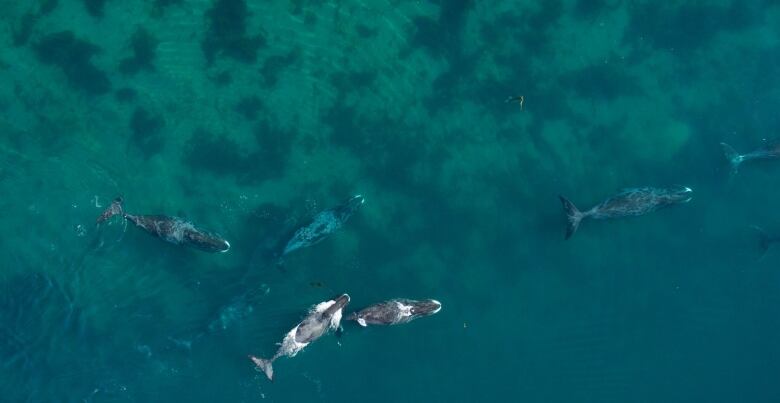Stunning drone footage reveals bowhead whales feeding, swimming patterns
UBC researcher spent 4 summers studying the mammals in Canadian Arctic
Bowhead whales like their afternoon siestas.
That's what UBC's Sarah Fortune realized after she and her fellow researchers gathered and analyzed stunning drone footage of the mammals in the eastern Canadian Arctic.
"The team was able to watchthe whalesand found that they spent the early morning feeding in deep water and then restedin shallow, coastal waters during the afternoon," Fortune said.
She and the team spentfour summers in Cumberland Sound,Nunavutjust a fewkilometresshy of the Arctic Circle studying the whales.

She believes this is the first intensive effort to studybowheadwhales with the use of an aerial drone, and says researchers now have a better understanding of how the whales forage and travel.
"When you're on a boat, you can't observe the entire body ... it's like the tip of the iceberg," she said.
But the aerial footage, along with the clarity of the northern waters, means researchers can now observe the whales' body language in real time. Fortune says the whales did not seem bothered by the drones.
"They paid it as much attention as a bird flying over. It was actually quite remarkable."
Foragingpatterns
Fortune says she is studying the whales to better understand how the whales are affected by climate change.
Thebowheadwhale is the longest-living marine mammal in the world, yet many questionsremain about the biology and feeding behaviour of this elusive animal.
The researchers realized that the whales were not foraging at the surface level, and preferred to dive deeper to eat, even though their prey small crustaceans was also at the sea surface.

"Maybe they're getting better prey deeper. We don't know why they are doing that yet and want to do some more analysis on that," Fortune said.
Swimming in formation
It was the social behaviour that fascinated Fortune the most.
"Although it is common to find small groups of whales traveling together, we saw they would often swimin coordinated patterns, almost like a V-formation," she said.
She theorized the whales swam in that pattern to save energy and ride the updraft.
The whales also often rubbed up against each other in a gentle manner.
"It's hard to say what this behaviour is about. I think we look at it and as humans want to say it is affectionate, but some of the whales also have roughened skin patches, so maybe this is theirway to shed that."
More research

Fortune says the thousands of images of the whales they collectedwill be used by other researchersto determine the population size of these whales.
They will use the unique markingsto identify the whales,age and body condition.
"This information will be really helpful as wemonitor changes to the population'shealth over time."













_(720p).jpg)


 OFFICIAL HD MUSIC VIDEO.jpg)
.jpg)



























































































